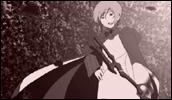Brave Story
- Year
- 2006
- Original title
- Brave Story
- Japanese title
- ブレイブ・ストーリ
- Director
- Cast
- Running time
- 111 minutes
- Published
- 23 April 2007



by Paul Jackson
Brave Story, the title of Studio Gonzo's second feature length anime, carries with it an unintentional irony. The film is so steeped in the genre traditions of fantasy cinema and video games, flaws and all, that its characters, settings and storytelling rarely rise above their familiar confines. This isn't brave filmmaking. In fact, it's quite the opposite - a polished crowd pleaser made with a very specific audience in mind. Which isn't to say that the film doesn't have its strengths, but like many of its kind, Brave Story's enjoyment stems from familiarity rather than any foundation shaking originality.
Wataru is a typical adolescent boy, dealing with increasingly universal growing pains - his parents are divorcing and his mum is unexpectedly hospitalised. While ghost hunting in a derelict building, however, Wataru encounters a mystical robed boy; his eyes are glazed over and the words he speaks appear nonsensical. The figure ascends a floating staircase, passes through a towering stone door and disappears. Naturally inquisitive , Wataru returns to the scene of his discovery, and later learns that the door leads to Vision; a world where travellers seeking the Goddess of Fortune are granted one wish. Seeing a solution to his problems, he climbs the stairs.
Brave Story's similarities with (Japanese) role playing games are laid bare early on. Shortly after Wataru has entered Vision, he is tested, awarded skill points and clad in the fantasy garb of a 'Hero Apprentice'. Inexplicably, Wataru is informed that if he is to get his wish granted he needs to collect five magical gems. Such a premise inevitably lends Brave Story a very episodic structure. Wataru's search for the Goddess of Fortune is broken down into a series of sub-quests, each with its own gem withholding monster / obstacle, increasingly grave consequences and grander set pieces. Consequently, the larger back story, involving an impending war between the llda Empire and Vision's Emperor, is never fully explained, barely seen, and frustratingly underdeveloped.
Superficially Brave Story resembles numerous Studio Ghibli features, especially Miyazaki's fantasy films. Vision's faux European cities recall both Howl's Moving Castle and Kiki's Delivery Service; some of its inhabitants would have looked equally at home in Spirited Away's bath house; and Wataru's mannerisms occasionally echo Pazu, the young protagonist of Laputa: Castle in the Sky. Unlike Miyazaki's films, however, Brave Story feels more squarely aimed at a family audience. Despite its emphasis on inner strength, the consequences of choices and the importance of family, Brave Story doesn't possess the depth of Miyazaki's best work and is unlikely to enchant audiences in quite the same way.
Some international influences are also plainly visible. The central premise has obvious similarities with C.S. Lewis's Narnia cycle of books, and a mirror that reflects people's inner most pain recalls Harry Potter's Mirror of Erised. Unfortunately, Brave Story never amounts to more than the sum of its parts. It too easily resorts to hackneyed genre clichés and character types, instead of pooling its influences into something truly original.
Gonzo is frequently criticised for prioritising technical excellence over narrative cohesion, so these flaws are, perhaps, unsurprising. The visuals, however, are a treat. Vision is characterised by the same flowing meadows and snow capped peaks that seem to have defined every fantasy world since the genre's inception, but director Koichi Chigira has included enough ravishing detail for it to remain appealing. The characters are simply, but effectively, designed and their movements are beautifully fluid.
Likewise, images are often memorable despite the structural flaws. A particularly striking scene sees Wataru emotionally embracing an identical döppelganger - the angry embodiment of his flaws and human weaknesses. Like Gonzo's previous efforts, however, some scenes are occasionally CGI heavy. Sadly, such imagery fails to fully convince. Their integration into traditional 2D scenes feels intrusive and distracting instead of heightening our enjoyment of the onscreen spectacle.
Brave Story may be a minor film in the pantheon of anime features, but it is a step forward for Studio Gonzo whose TV work is already distinguished. Although still flawed there is a marked improvement since Origins: Spirits of the Past, Gonzo's first feature length production. It would be wrong to assume that Brave Story represents the studio at their best given the prominence of its shortcomings. But, if the advancements seen here continue, Gonzo could soon be a major contender in the theatrical anime market.